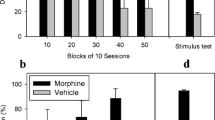Abstract
Rats were trained to discriminate arecoline (1.74 mg/kg) from saline in a milk-reinforced (variable interval 12 s) two-lever operant paradigm. The discriminative stimulus (DS) effects of arecoline were antagonized by atropine sulfate, but not by atropine methylnitrate or mecamylamine. In contrast to the effects on discrimination, atropine did not antagonize the response rate suppressant effects of arecoline. The DS effect of arecoline completely generalized to oxotremorine, partially generalized to pilocarpine, and did not generalize to nicotine. These data demonstrate that the DS effect of arecoline depends on central muscarinic receptors.
Similar content being viewed by others
References
Baker RW, Chothia CH, Pauling P, Peteher TJ (1971) Structure and activity of muscarinic stimulants. Nature 230:439–445
Barlow RB, Berry KJ, Glenton PAM, Nikolaou NM, Soh KS (1976) A comparison of affinity constants for muscarinic-sensitive acetylcholine receptors in guinea-pig atrial pacemaker cells at 29°C and in ileum at 29°C and 37°C. Br J Pharmacol 58:613–620
Barlow RB, Burston KN, Vis A (1979) Three types of muscarinic receptors? Br J Pharmacol 68:141–142
Barry H III (1974) Classification of drugs according to their discriminable effects in rats. Fed Proc 33:1814–1824
Birdsall NJM, Burgen ASV, Hulme EC (1978) The binding of agonists to brain muscarinic receptors. Molec Pharmacol 14:723–736
Birdsall NJM, Hulme EC, Burgen A (1980) The character of the muscarinic receptors in different regions of the rat brain. Proc R Soc Lond (Biol) 207:1–12
Chance WT, Kallman MD, Rosecrans JA, Spencer RM (1978) A comparison of nicotine and structurally related compounds as discriminative stimuli. Br J Pharmacol 63:609–616
Glennon RA, Young R, Rosecrans JA, Kallman MJ (1980) Hallucinogenic agents as discriminative stimuli: A correlation with serotonin receptor affinities. Psychopharmacology 68:155–158
Herz A (1963) Excitation and inhibition of cholinoceptive brain structures and its relationship to pharmacologically induced behavior changes. Int J Neuropharmacol 2:205–216
Herz A, Holzhauser H, Teschemacher H (1967) Central nicotine-and muscarine-like properties of cholinomimetic drugs with regard to their lipid solubility. Ann NY Acad Sci 142:21–26
Kawamura H, Domino EF (1969) Differential actions of m and n cholinergic agonists on the brain stem activating system. Int J Neuropharmacol 8:105–115
Kuhn DM, Greenberg I, Appel JB (1974) Differential effects on lever choice and response rate produced by d0amphetamine. Bull Psychon Soc 3:119–120
McGeer PL, McGeer EG (1979) Central cholinergic pathways. In: Barbeau A, Growdon JH, Wurtman RJ (eds) Nutrition and the brain, vol V. Ravein New York, pp 177–199
Meltzer LT, Rosecrans JA, Aceto MD, Harris LS (1980) Discriminative stimulus properties of the optical isomers of nicotine. Psychopharmacology 68:283–286
Morrison CF, Goodyear JM Sellers CM (1969) Antagonism by antimuscarinic and ganglio-blocking drugs of some of the behavioral effects of nicotine. Psychopharmacologia 15:341–350
Olds ME, Domino EF (1969) Comparison of muscarinic and nicotinic cholinergic agonists on self-stimulation behavior. J Pharmacol Exp Ther 166:189–204
Overton D (1974) Experimental methods for the study of state-dependent learning. Fed Proc 33:1800–1813
Overton D (1979) Influence of shaping procedures and schedules of reinforcement on performance in the two-bar discrimination task: A methodological report. Psychopharmacology 65:291–298
Pradhan SN, Dutta SN (1970) Behavioral effects of arecoline in rats. Psychopharmacologia 17:49–58
Pradhan SN, Dutta SN (1971) Central cholinergic mechanism and behavior. Int Rev Neurobiol 14:173–232
Riehl JL, Paul-David J, Unna KR (1962) Comparison of the effects of arecoline and muscarine on the central nervous system. Int J Neuropharmacol 1:393–401
Schechter MD, Rosecrans JA (1972a) Effect of mecamylamine on discrimination between nicotine-and arecoline-produced cues. Eur J Pharmacol 17:179–182
Schechter MD, Rosecrans JA (1972b) Atropine antagonism of arecolinecued behavior in the rat. Life Sci 11:519–523
Schechter MD, Rosecrans JA (1972c) Nicotine as a discriminative cue in rats: Inability of related drugs to produce a nicotine-like cueing effect. Psychopharmacologia 17:379–387
Schuster CR, Balster RL (1977) The discriminative stimulus properties of drugs. Adv Behav Pharmacol 1:86–139
Seiden LS, Dykstra LA (1977) Psychopharmacology: A biochemical and behavioral approach. Van Nostrand Reinhold New York
Sitaram N, Moore AM, Gillin JC (1978) Induction and resetting of REM sleep rhythm in normal man by arecoline: Blockade by scopolamine. Sleep 1:83–90
Yamamoto KI, Domino EF (1967) Cholinergic agonist-antagonist interactions on neocortical and limbic EEG activation. Int J Neuropharmacol 6:357–373
Zetler G (1971) Pharmacological differentiation of nicotinic and muscarinic catalepsy. Neuropharmacology 10:234–246
Author information
Authors and Affiliations
Rights and permissions
About this article
Cite this article
Meltzer, L.T., Rosecrans, J.A. Discriminative stimulus properties of arecoline: A new approach for studying central muscarinic receptors. Psychopharmacology 75, 383–387 (1981). https://doi.org/10.1007/BF00435858
Received:
Accepted:
Issue Date:
DOI: https://doi.org/10.1007/BF00435858




